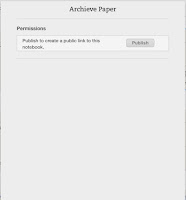As Technologists, we are being inundated with data, lots of it from almost everything we do. The easy route is to just delete, or make a folder on your
hard drive, and dump it in there thinking you'll sort it later.
But there are a few simple tricks that will solve you problem and make it easy to retrieve.
First is Email, I use gmail its still the leading service, despite its age, I get so much, some important and these get tagged and put into a correct folder, the rest just get marked as read, I never ever delete emails. Important ones that I want to keep out side of
Gmail, I send to my Evernote account, via the secret email address they give, more on this later.
Never ever rely on your hard drive to store important things, I have, like so many done this and lost it all when the disk failed, and it will. With the cloud now so easy to access, I store all items in one of two places, first
Google Drive, this has to be a no brainer, its easy to set up, easy to use, and you get so much free space, and is so well integrated with gmail, next comes
DropBox, a paid for service, well there is a free service and its quite large, but my needs have gone beyond this, and it's here I store almost every working file, most are cad files and project documents we use daily, the beauty of DropBox is the sharing, I share all my business files with my partner, and he sees the updates almost instantly.
Now lets get back to
Evernote, a product with a difference, here I store any document, scanned or otherwise, my new printer has such a sweet
scanning facility, and used with
PDFpen, if I get paper in the post, I scan it, and use the builtin "send to Evernote" function and dump the paper. Evernote has the best search ever, the
OCR scans the pdf ready for me to search, I pay for the premier account, so its almost instant, free accounts wait for a while, but its done. Don't forget to add the app to your browser, searching for anything from say Chrome will show whats on the web, but also whats in you private archive in Evernote. Your private archive of data will be the subject of a more detailed blog later.
Books I have a problem with, I buy so many, I am a sucker for a good book, my collection, and I will not pass on any book, sorry, is growing, my construction books in particular I scan, not all of them, but the index, and important pages, these I send to Evernote, ready for search, I'll write a new blog on this very soon as there is more to this than just scanning,
Kindle and ebooks spring to mind and my highlights.
Photos and my video's used to be a problem, but now I have four different safeguards, Google Drive, Flickr, dropbox, and iPhoto on my mac, all store any electronic photo I take, its automatic and I just don't ever have to think about it, most of my photos are taken with my mobile, the quality is just fine for most things, it auto syncs with all the above, and best of all, it has lat long embedded so search is so easy, which brings me onto my favourite, which is Google Photo, is was with no question iPhoto, but the service google offers is so much better. so all nicely backed up. In many practices, I used to get stinging emails from the IT department, saying I had yet again filled up the server with photos, not any more.
I still have to keep paper, its a pain, and defies the new search and find I am so used to in computer land, and is hosted in an old filing cupboard in my garage. Most are scanned, but the law seems to say keep, so I do.
With all the above, its hard to say no to data, now its more the better, OCR has opened up search to all the content, learning how to use this now becomes the next holly grail, tagging and to some extent, adding files to folders, although I do this simply to allow sharing specific sets of data.
I write profusely, with this blog and the others I looks after, a service I find invaluable is
ifTTT look for it or follow the link, its an automated service thats free, which has rules, if I write a new blog it will copy the blog to Evernote, same goes for a lot of other services like diary events.
Todays photo is a vey old detail I like, neat and so full of design.
























